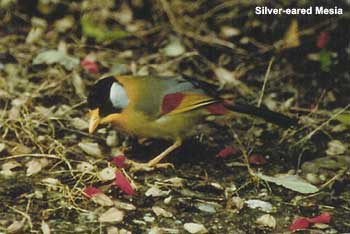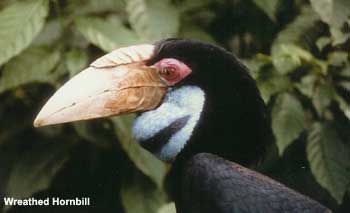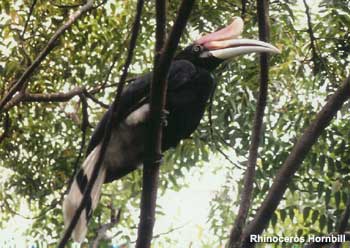The crisp rustling of the leaves behind the thick Pandanus vegetation was the first indication that the bird was there. The intense humidity in the gully added to the tension as I gently raised my head to a gap in the rattan palms. Peering through, I fixed my eyes on a dumpy, thrush-sized shape feeding vigorously among the leaf litter. Then, after very carefully lifting my binoculars my suspicions were confirmed as I was dazzled by its golden gorget and flanks and deep iridescent blue hind-crown, nape and tail, complemented by jet-black face - it was a male
Gurney's Pitta, the climax of my first trip to Asia.
For two months (March and April 1998) I and fellow birders Howard Fearn (from North-West England) and Laurence Pitcher (from South-East England) birded in Malaysia and Thailand, around breath-taking mountains, dense jungle, waterliliy-covered lakes, mangroves and warm, emerald seas lapping on golden beaches.
These two culturally diverse and inexpensive countries produced a trip-list of over 350 species, many of them concentrated in a select few areas of forest.
Malaysia
In Malaysia, a country formed as recently as 1955 from the former British colonies of Malaya, Sarawak and Sabah, our efforts were concentrated on Fraser's Hill, an old colonial hill station, and Taman Negara National Park - reputedly the oldest jungle in the world and at 4,343 sq km the largest protected area of primary rainforest on peninsular Malaysia.
Fraser's Hill: Fraser's Hill lies 100km north of Kuala Lumpur, and because of its altitude of over 1,500m and resultant cooler climate proved to be an ideal place to begin and end the trip, enabling us to acclimatise at the beginning and cool off at the end, after the baking temperatures of Taman Negara and Thailand. The altitude means that it has a lot of birds which are absent from the lower sites.
Arriving there was a surreal experience; I wasn't expecting to see a golf course and Mediterranean-style apartments cut into virgin rainforest!
We were immediately greeted by several of the common residents here including
Silver-Eared Mesia, Chestnut-capped Laughing Thrush and
Black-throated Sunbird.

It was straight into birding on arrival, seeing flocks of
Crested Honey Buzzards on migration, a
Grey Nightjar perched on the police station,
Malayan Whistling Thrush and
Slaty-backed Forktail at dawn along the stream by the entrance barrier, and my first ever
Hornbill - a
Wreathed, all in the first two days.

As we began exploring Fraser's Hill we became familiar with the commoner birds of the area such as
Large Niltava, Blue Nuthatch, White-throated Fantail, Asian Paradise-Flycatcher, Fire-tufted and
Black-browed Barbet, Long-tailed Broadbill, Orange-bellied and
Buff-bellied Flowerpecker, Streaked Spiderhunter, Little Pied, Grey-headed, Rufous-browed and
Asian Brown Flycatcher, Mountain and
Dark-necked Tailorbird, Mountain Leaf-Warbler, Black-eared and
White-browed Shrike-Babbler, Blue-winged Minla, Long-tailed Sibia, Mountain Fulvetta, Chestnut-crowned Laughing Thrush, Green Magpie, Lesser Racket-tailed and
Bronzed Drongo, Orange-bellied Leafbird, Scarlet Minivet, Malaysian Cuckoo-Shrike, Large Wood-Shrike, Greater and
Lesser Yellownape, Orange-backed Woodpecker, Blue-throated Bee-eater and
Little Cuckoo-Dove! It was a lot to take in and we often didn't know where to look first!
As our stay wore on we experienced more and more magical moments: a male
Blue-and-White Flycatcher joining a tree full of
Mugimaki Flycatchers by the mosque; getting drenched in a sudden downpour while watching
Brown Bullfinches in the High Pines garden; rescuing a
White-bellied Swiftlet from a spider's web by using an extended tripod leg; a
Ferruginous Flycatcher and a sublime
Red-bearded Bee-eater by the Dump, and catching rare glimpses of Siamang Gibbons swinging through the canopy.
The network of different trails and roads at Fraser's Hill provided more excellent birds. The Bishop Trail is a jungle trail with flocks (or 'waves' as they are known) moving through at all times of day. This was the only site at Fraser's where we saw
Rusty-naped Pitta, Large Scimitar-Babbler, White-tailed Robin, Pygmy Wren-Babbler and
Bar-backed Partridge. A family of
Lesser Shortwings (a pair and a juvenile) showed extremely well on this trail.
The New Road is a 12km road. It was being built to take traffic downhill to The Gap. However, it was not open to traffic and very little work was being done at the time, so as a result offered consistently good birding, coupled with panoramic, scenic views. Several species of Hornbill were seen regularly, including the magnificent
Great Hornbill, as were plenty of woodpeckers and the diminutive
Black-thighed Falconet.

The Telecom Loop is a long walk full of feeding flocks of birds. If you are lucky you should be able to see the beautiful and wonderfully named
Cutia! We saw a very cute pair along the loop every time we looked for them, and migrants here included
Chestnut-winged Cuckoo and
Tiger Shrike.
The Gap: The Gap, at the bottom of the Fraser's Hill road, is another rather surreal place. The only accommodation is at the Resthouse, a quaint English-style B & B complete with afternoon tea on the lawn. However, any thoughts that we were in England were completely dispelled as
Asian Fairy Bluebirds and
Red-rumped Swallows of the local
badia race passed overhead,
Verditer Flycatchers and
Blue-crowned Hanging Parrots showed in the garden, and a male
Rufous Piculet appeared in the porch while we were at breakfast one morning!
Using the Resthouse as a base we made frequent forays up the first 3 kilometres of the Fraser's Hill. We saw some wonderful birds by this road including
Marbled Wren-Babbler, Chestnut-backed Scimitar Babbler, Orange-breasted Trogon, Helmeted Hornbill, Velvet-fronted Nuthatch, Yellow-vented Pigeon, Everett's White-eye and
Grey-capped Woodpecker. We were told of a reliable Tiger sighting along this road around the time we were there!
Taman Negara National Park
A piece of advice for anyone visiting Taman Negara is "don't try too hard in the first day or two". This fine tip was given to us by two visiting Australian birders who explained that we could get to know a lot of the commoner species by spending a morning in the resort, sitting under a fruiting fig tree with binoculars, a field guide and a notebook. The fruiting fig tree we sat beneath was heaving with orioles, bulbuls, spiderhunters, hornbills, leafbirds, pigeons, hanging parrots, barbets and flowerpeckers, all seen in a very leisurely, chilled out manner.
Once you've started exploring the trails you may find that jungle birding can be tough, but don't get too down-hearted if you go more than an hour without seeing a bird. Many are seen during 'waves' - feeding flocks that move through, usually pretty rapidly. So, stay alert! A wave made up of at least 10 species may be round the next corner...

In the dry season try to find small pools on the jungle floor. If you do you may be spellbound by gems such as
Banded Pitta and
Red-bearded Bee-eater coming in to drink and bathe.
Most naturalists stay overnight in one of the hides, and Kumbang is probably the best.
This area is excellent for pittas - we saw
Blue-winged, Garnet, Hooded and
Banded. It was the only place where members of our party saw
Rufous-tailed Shama and the famed speciality -
Great Argus. If you've got the stamina you can stay up late to try and see Asian Elephant and tapir that occasionally visit the salt lick after dark.
Much sought-after is the mysterious
Masked Finfoot, an aquatic species that looks like a cross between a Coot and a Crane! Little is known about this species breeding habits, but it is not seen in Taman Negara after April. I first saw one, a male, from a moving boat along the River Tahan. It completely ignored the boat's motor and my fevered shouts to the boatmen to "Stop!", then fed unconcerned by the bank as we paddled to within 30 yards.
Taman Negara was far and away the best place we visited for mammals with Silvered Leaf Monkey, Long-tailed Macaque, Giant Squirrel, Presvost's Squirrel, Malay Palm Civet, Wild Pig, Greater and Lesser Mousedeer, and Barking Deer all seen during the day-time.
At night a Colugo (Flying Lemur) was spot-lighted by the River Trail at Taman Negara whilst we were looking for a calling
Reddish Scops-Owl, and several Common Porcupines could be found around the main resort. We also saw fresh Asian Elephant footprints along the track from Kumbang Hide to Kuala Tahan and heard White-handed Gibbons.
Thailand
Thailand is a predominantly Buddhist country with many amazing temples. I found the people to be very warm and friendly, despite their often being a language barrier (eg only one person in the village of Thale Noi spoke English). It is a less Westernised country than Malaysia which you can see and feel as soon as you cross the border.
Krabi: If time limits your visit to Thailand alone, don't worry about missing Masked Finfoot because one of the most accessible sites in the world for this species is near Krabi, in the extreme south of the country. To make the connection, take one of the boat trips into the heart of the secluded mangroves. We went with the legendary Mr.Dai, a local fisherman.
He found a
Finfoot for us, whistled out
Mangrove Pitta and
Ruddy Kingfisher and then took us out into Krabi Bay, where waders and terns sat out high-tide on the poles of fishing nets. Despite being on a bobbing boat, we identified
Nordmann's Greenshank, Crested Tern, Great Knot and
Terek Sandpiper amongst large numbers of roosting birds. The Kho Phi Phi Islands lie a mere two-hour boat journey from Krabi. The main island was quite commercialised (and is even more so now as it is where the film 'The Beach' was set), but we got away from the development to some peaceful, superb birding by taking an evening boat trip to Phi Phi Leh, a small uninhabited island where 1,000
Lesser and
Christmas Island Frigatebirds wheeled around before going to roost and 50
Black-naped Terns gathered at the foot of the limestone cliffs.
By now my appetite for wetland birds had been whetted enough for a solo jaunt to Thale Noi, a huge swamp connected to the north side of Songkhla Lake. I arrived at this paradise to be greeted by a seemingly endless carpet of pink waterlilies, fishing boats,
marsh terns (
Whiskered and
White-winged Black),
Pheasant-tailed and
Bronze-winged Jacana, White-breasted Waterhen, Purple Swamp-hen, Cotton Pygmy-Geese, Lesser Whistling-Duck and
bitterns (Black, Cinnamon and
Yellow), all bathed in the evening sun.
The heat meant sleepless nights and this was added to by squawking Swamp-hens and raucous
Oriental Reed Warblers within yards of the wooden lake-side bungalow I stayed in. The owner of the bungalows was very acommodating, taking me in his boat over to the village every evening for food, and also once taking me on a boat-trip around Thale Noi. Here, there were large colonies of nesting
Little Cormorants, egrets (Great, Intermediate, Little and
Cattle),
Purple and
Pond Herons.
In the paddyfields by the approach road
Long-toed and
Temminck's Stints, Black-winged Stilts and
Wood Sandpipers fed side-by-side in the shallow pools, a female
Painted Snipe crept furtively out from the rushes, a
Red-wattled Lapwing flew in over the fields, a
Large-billed Crow fed on a pond heron corpse, and a pair of
Plain-backed Sparrows displayed on fence posts, while
Oriental Pratincoles hawked overhead and an
Eastern Marsh Harrier quartered nearby fields.
In contrast to Malaysia, little English is spoken in Thailand, so at Thale Noi communication came through a game of football. Stilted conversations were soon replaced by make-shift goal posts, especially after I mentioned I was from Manchester. This gained the attention of many villagers and it wasn't long before the whole village was either playing, or watching, smiling and cheering! A magic evening!
Khao Nor Chuchi: In Krabi we stayed at Jack House, a guesthouse run by Yotin Meekiou and his wife where clean, basic rooms cost us 31 pence a night! When we were there Yotin was a warden at Khao Nor Chuchi, then the only known site in the world for Gurney's Pitta. His exceptionally useful advice was to prove vital in locating some of the rarer species in the area, such as
Spotted Wood-Owl, Brown Wood-Owl, Banded Kingfisher and
Malaysian Honeyguide.
Seeing
Gurney's Pitta provoked a heady cocktail of strong emotions as the species has a fascinating history. Once fairly common throughout peninsular Thailand and southern Burma, it was thought to be extinct for many years due to loss of habitat through uncontrolled deforestation. Astonishingly, a male was found by British birder Phil Round in an illegal bird market in Bangkok in 1986. The site where it had been trapped was ascertained from the dealer, and after taking some sound recordings from that single bird, Gurney's Pitta was rediscovered at Khao Nor Chuchi. The conservation importance of the area had already been recognised the year before, during an examination of forest cover maps prepared from satellite photographs aimed at identifying the last remnants of lowland rainforest in southern Thailand. The Khao Pra Bang Khram non-hunting area was established as a wildlife sanctuary in 1987, and it now attracts large numbers of birders and conservationists.
Gurney's Pitta is the most intensely surveyed and wardened of the 318 species recorded here to date, but its future hangs in the balance with just 1 6 pairs remaining in 1997. We can look to the future and visualise the conservation measures, hard work and increased knowledge of its precise ecological requirements paying off and a brighter future for this enigmatic and stunningly beautiful species...
Many thanks to Adam, Howard and Laurence for the use of photos in the preparation of this article.
Relevant web-sites to check out:
Tourism Malaysia:
www.tourismmalaysia.gov.my/
Taman Negara National Park, Malaysia:
www.taman-negara.com
Tourism Authority of Thailand:
www.tourismthailand.org
Thailand Birding:
www.thailandbirding.com
Krabi, Thailand (tourist guide):
www.krabisite.com
Khao Nor Chuchi:
http://diamond.mahidol.ac.th/~fndsr/
Oriental Bird Club:
www.orientalbirdclub.com
(
Stop Press -Gurney's Pitta rediscovered in Burma)
www.orientalbirdclub.org/news/savegurneys4.html




